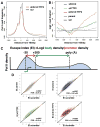mRNA decapping factors and the exonuclease Xrn2 function in widespread premature termination of RNA polymerase II transcription
- PMID: 22483619
- PMCID: PMC3806456
- DOI: 10.1016/j.molcel.2012.03.006
mRNA decapping factors and the exonuclease Xrn2 function in widespread premature termination of RNA polymerase II transcription
Abstract
We report a function of human mRNA decapping factors in control of transcription by RNA polymerase II. Decapping proteins Edc3, Dcp1a, and Dcp2 and the termination factor TTF2 coimmunoprecipitate with Xrn2, the nuclear 5'-3' exonuclease "torpedo" that facilitates transcription termination at the 3' ends of genes. Dcp1a, Xrn2, and TTF2 localize near transcription start sites (TSSs) by ChIP-seq. At genes with 5' peaks of paused pol II, knockdown of decapping or termination factors Xrn2 and TTF2 shifted polymerase away from the TSS toward upstream and downstream distal positions. This redistribution of pol II is similar in magnitude to that caused by depletion of the elongation factor Spt5. We propose that coupled decapping of nascent transcripts and premature termination by the "torpedo" mechanism is a widespread mechanism that limits bidirectional pol II elongation. Regulated cotranscriptional decapping near promoter-proximal pause sites followed by premature termination could control productive pol II elongation.
Copyright © 2012 Elsevier Inc. All rights reserved.
Figures







Comment in
-
Decapping goes nuclear.Mol Cell. 2012 May 11;46(3):241-2. doi: 10.1016/j.molcel.2012.04.016. Mol Cell. 2012. PMID: 22578538
References
-
- Andrulis ED, Werner J, Nazarian A, Erdjument-Bromage H, Tempst P, Lis JT. The RNA processing exosome is linked to elongating RNA polymerase II in Drosophila. Nature. 2002;420:837–841. - PubMed
-
- Benjamini Y, Hochberg Y. Controlling the false discovery rate: a practical and powerful approach to multiple testing. J Royal Stat Soc Ser B. 1995;57:289–300.
-
- Bentley DL, Groudine M. A block to elongation is largely responsible for decreased transcription of c-myc in differentiated HL60 cells. Nature. 1986;321:702–706. - PubMed
-
- Brown SA, Imbalzano AN, Kingston RE. Activator-dependent regulation of transcriptional pausing on nucleosomal templates. Genes Dev. 1996;10:1479–1490. - PubMed
Publication types
MeSH terms
Substances
Associated data
- Actions
Grants and funding
- GM063873/GM/NIGMS NIH HHS/United States
- F31 GM072099/GM/NIGMS NIH HHS/United States
- P30 CA046934-17/CA/NCI NIH HHS/United States
- R01 AI049558/AI/NIAID NIH HHS/United States
- 3R01GM063873-06S1/GM/NIGMS NIH HHS/United States
- P30 CA046934/CA/NCI NIH HHS/United States
- F31GM72099/GM/NIGMS NIH HHS/United States
- T32 GM008730/GM/NIGMS NIH HHS/United States
- F31GM095249/GM/NIGMS NIH HHS/United States
- F31 GM095249/GM/NIGMS NIH HHS/United States
- AI49558/AI/NIAID NIH HHS/United States
- S10RR023015/RR/NCRR NIH HHS/United States
- T32-GM08730/GM/NIGMS NIH HHS/United States
- R01 GM063873/GM/NIGMS NIH HHS/United States
- S10 RR023015/RR/NCRR NIH HHS/United States
LinkOut - more resources
Full Text Sources
Other Literature Sources
Molecular Biology Databases

